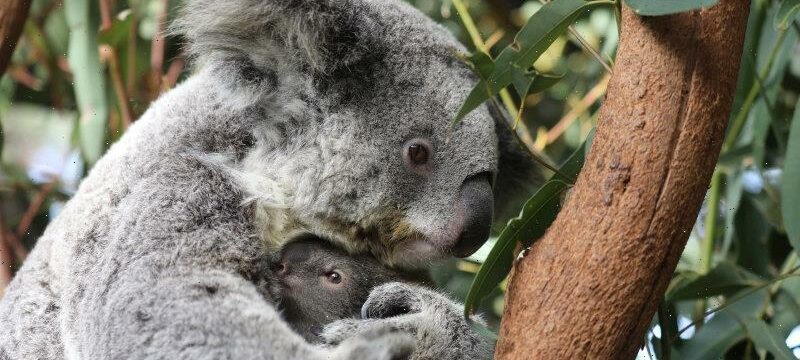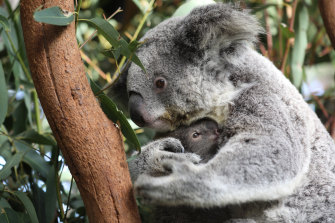That Australia is now on the brink of losing both the Great Barrier Reef and the koala is both shameful and utterly in keeping with our stewardship of this continent and its creatures since European settlement.
Australia has the worst record of mammalian extinction on earth and the rate of habitat loss and extinctions is accelerating rather than slowing.
Koalas in a breeding program at the Australian Reptile Park.
But there is a key difference between the two looming catastrophes.
So far as a nation we have proved reluctant to lead the world in greenhouse gas emission reduction efforts that would save the reef. And even if we had cut emissions in line with that goal, we could not achieve it alone.
But the koala’s fate rests entirely in our own hands. In much of the country we must now choose between development-as-usual or koalas. We can’t have both.
On Friday, federal Environment Minister Sussan Ley acknowledged how serious the koalas’ plight is, announcing that they were to be listed as endangered in Queensland, NSW and the ACT.
The destruction of koala populations has broadly occurred in two great waves, explains koala ecologist Stephen Philips. In the years after settlement, millions were slaughtered for fur.
The last great open season was held in “black August” in Queensland in 1927, when between 600,000 and 800,000 were shot and skinned.
Later recovering populations probably began to collapse again in inland Queensland and NSW in the 1990s, says Dr Philips, though historical koala data is patchy and contested.
The rapid decline was caused by land-clearing and exacerbated by climate change and disease. It’s well known that koalas cannot live without specific eucalyptus trees, but less well known that, when temperatures exceed 35 degrees, they can no longer cool themselves by embracing their trees.
In this heat, they flee to the ground where they are hit by cars, taken by dogs or simply expire as they begin to metabolise their own muscle for lack of fluids.
Stressed populations succumb faster to diseases such as chlamydia.
“In the past decade there’s been a 90 per cent decline in the Gunnedah koala population, which was once the gold standard,” says Dr Phillips, who believes that population now to number in the hundreds.
In 2017, he visited 150 sites in the Pilliga, another region once host to a healthy population, and found scat at none of them.
“They are pretty well gone now,” he says.
Research by the Australian Conservation Foundation released on Tuesday found that the federal government had approved 63 projects that would result in the clearing of more than 25,000 hectares of koala habitat since the species was declared vulnerable to extinction 10 years ago
In southern Queensland and NSW, the survivors now cling to the cooler coast on fertile land coveted by farmers, tree-changers and developers. In Victoria, many of the larger populations, free of the diseases more prevalent to the north are descended from captive breeding programs. While healthier in number, these populations are poor in the genetic diversity needed to ensure the species’ survival.
Confronted with this rapid collapse, many observers and campaigners have welcomed Ley’s announcement. Some have noted that she could easily have sat on the decision until after the election rather than act, and that the money she has dedicated to the koala is significant and well targeted.
But listing the animal will not save it. As Dr Philips puts it, unless the few remaining koalas and their fragile remnant habitats are “wrapped in cotton wool”, they will soon become regionally extinct in NSW and Queensland and could be lost entirely.
Greens Senator Sarah Hanson has come to the same conclusion, calling on Friday morning for the federal government to introduce laws for an immediate moratorium on koala habitat destruction.
“That means no more land clearing in koala habitat. No more mines and quarries in koala habitat. That means no more approvals and licences for big property developers to clear and bulldoze in the homes of koalas,” she said.
The cost of such a moratorium would be significant.
But Deborah Tabart, chief executive of the Australian Koala Foundation, who has lobbied for such a law for years, notes there is international precedent.
As its entry to World War II approached, the United States Congress sought to stave off the extinction of its national symbol and passed the Bald Eagle Protection Act, prohibiting the killing of the birds or the destruction their nesting grounds.
The laws, along with other conservation efforts, led to the numbers bouncing back and then climbing before, in 2007, the birds were removed from the endangered list.
Surely, says Ms Tabart, Australia’s concern for the koala matches America’s for the eagle.
The Morning Edition newsletter is our guide to the day’s most important and interesting stories, analysis and insights. Sign up here.
Most Viewed in Environment
From our partners
Source: Read Full Article

